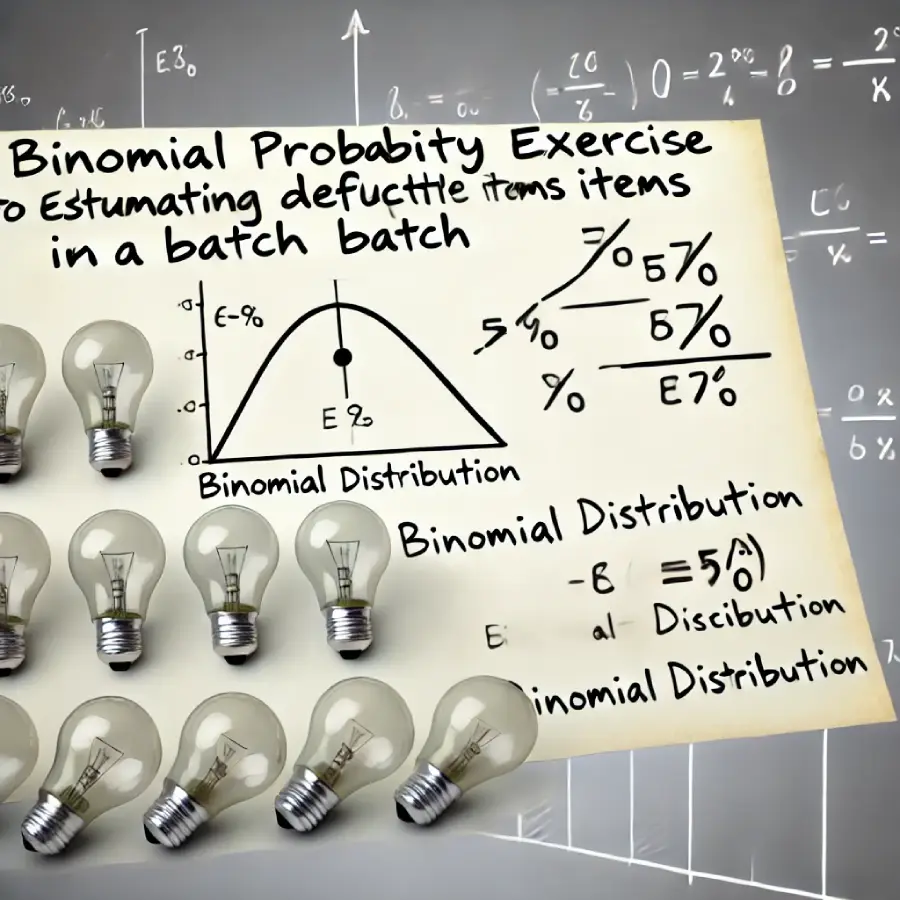Exercise
Suppose a large batch of light bulbs contains 10% defective bulbs. If we randomly select 3 bulbs, what is the probability of the following:
1. Exactly one bulb is defective?
2. No bulbs are defective?
3. At least one bulb is defective?
4. How many defective bulbs are expected to be found?
5. What is the variance?
Solution
This problem involves a binomial distribution, where the number of trials is 3, and the probability of success (finding a defective bulb) in each trial is 0.10.
For a binomial distribution:
– \( n = 3 \) (the number of trials)
– \( p = 0.10 \) (the probability of finding a defective bulb)
– \( q = 1 – p = 0.90 \) (the probability of not finding a defective bulb)
The probability mass function is given by:
\[
P(X = k) = \binom{n}{k} p^k q^{n-k}
\]
where:
– \( X \) is the number of defective bulbs found,
– \( k \) is the number of successes (defective bulbs),
– \( \binom{n}{k} \) is the binomial coefficient.
Question 1: Probability of exactly one defective bulb.
We need to find \( P(X = 1) \):
\[
P(X = 1) = \binom{3}{1} (0.10)^1 (0.90)^{3-1}
\]
\[
P(X = 1) = 3 \times 0.10 \times 0.81 = 0.243
\]
So, the probability of finding exactly one defective bulb is 0.243.
Question 2: Probability of no defective bulbs.
We need to find \( P(X = 0) \):
\[
P(X = 0) = \binom{3}{0} (0.10)^0 (0.90)^3
\]
\[
P(X = 0) = 1 \times 1 \times 0.729 = 0.729
\]
So, the probability of finding no defective bulbs is 0.729.
Question 3: Probability of at least one defective bulb.
This is the complement of finding no defective bulbs, so:
\[
P(X \geq 1) = 1 – P(X = 0)
\]
\[
P(X \geq 1) = 1 – 0.729 = 0.271
\]
So, the probability of finding at least one defective bulb is 0.271.
Question 4: Expected number of defective bulbs.
The expected value \( E(X) \) for a binomial distribution is given by:
\[
E(X) = n \times p = 3 \times 0.10 = 0.3
\]
So, the expected number of defective bulbs is 0.3.
Question 5: Variance.
The variance \( \text{Var}(X) \) for a binomial distribution is given by:
\[
\text{Var}(X) = n \times p \times q = 3 \times 0.10 \times 0.90 = 0.27
\]
So, the variance is 0.27.
—
Summary of Answers
1. The probability of exactly one defective bulb is 0.243.
2. The probability of no defective bulbs is 0.729.
3. The probability of at least one defective bulb is 0.271.
4. The expected number of defective bulbs is 0.3.
5. The variance is 0.27.

